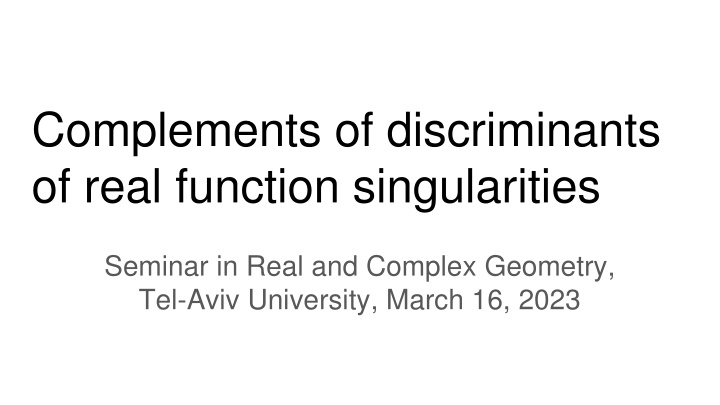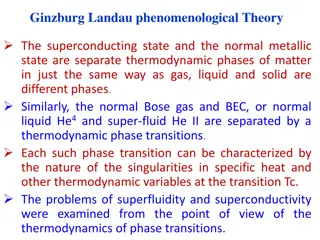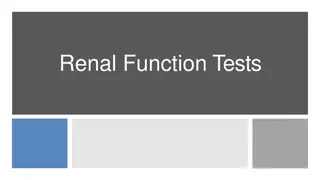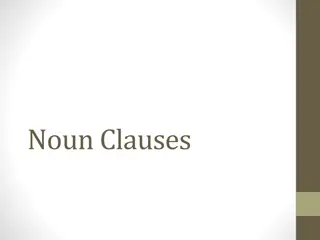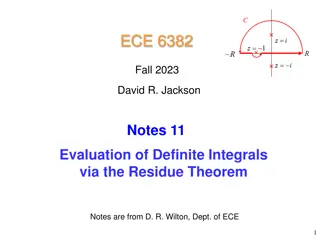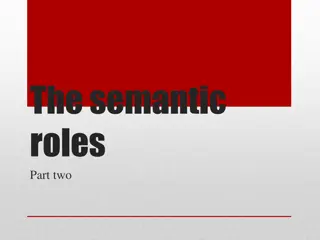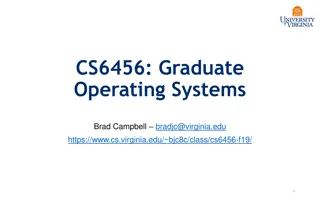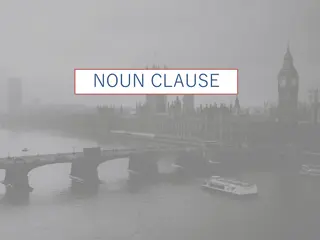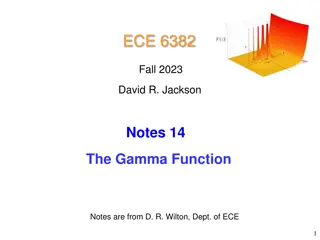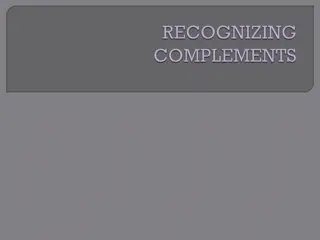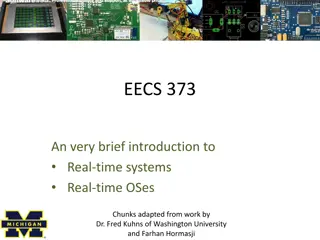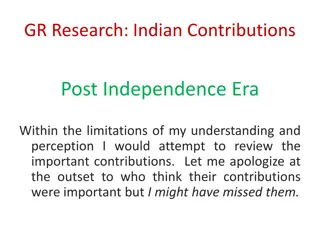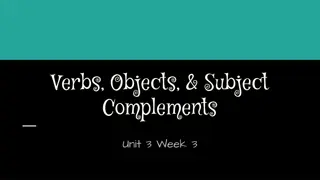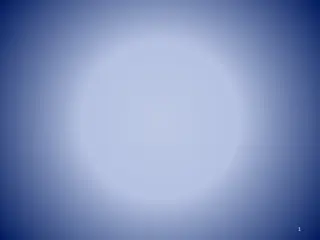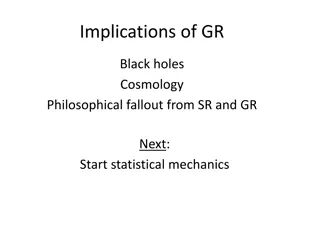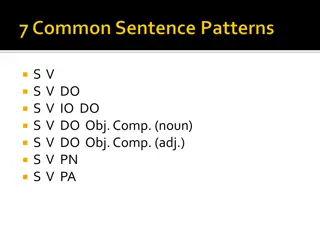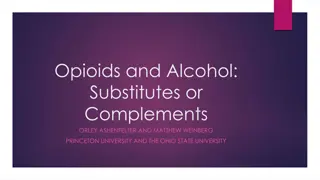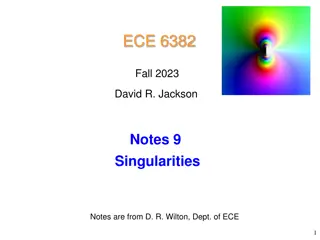Complements of discriminants of real function singularities
Delve into the analysis of complements of discriminants in real function singularities at the Seminar in Real and Complex Geometry hosted by Tel-Aviv University on March 16, 2023. Explore the intricate connections and implications of these mathematical concepts in a dynamic academic setting. Gain valuable insights and broaden your understanding of the complex interplay between real function singularities and their complements.
Download Presentation

Please find below an Image/Link to download the presentation.
The content on the website is provided AS IS for your information and personal use only. It may not be sold, licensed, or shared on other websites without obtaining consent from the author.If you encounter any issues during the download, it is possible that the publisher has removed the file from their server.
You are allowed to download the files provided on this website for personal or commercial use, subject to the condition that they are used lawfully. All files are the property of their respective owners.
The content on the website is provided AS IS for your information and personal use only. It may not be sold, licensed, or shared on other websites without obtaining consent from the author.
E N D
Presentation Transcript
Complements of discriminants of real function singularities Seminar in Real and Complex Geometry, Tel-Aviv University, March 16, 2023
Notion of Discriminant f: (Cn, Rn,0) (C,R,0) a real holomorphic function with singularity at 0: df(a)=0; F: (Cnx Cq, Rnx Rq, 0) (C, R, 0) its smooth deformation, i.e. a family of functions f depending on parameter Cq of , f0 f. f is a real function (i.e. takes real values on Rn) for real values of parameter . Discriminant (F) of family F is the set of values Rq such that f has a critical point in Rn with critical value 0. Complex discriminant C(F) of F is the set of values Cq such that f has a critical point in Cn with critical value 0. Obviously, (F) C(F) Rq ; (maybe a strict inclusion). Or: for any Cq, consider the zero set of corresponding function, V = f -1(0), then complex discriminant C(F) is the set of parameters for which it is a regular submanifold.
Examples f=x3, F(x; 1, 2) = x3+ 1x + 2, discriminant = semicubic parabola ( 2/2)2+( 1/3)3=0 f=x4, F(x; 1, 2, 3) = x4+ 1 x2+ 2x + 3, discriminant = swallowtail
The discriminant separates the parameter space into several domains in any of which which the real zero level sets f -1(0) Rnhave a fixed topology. In the case of functions in 1 variable, the topology is just the number of points: for x3 it is equal to 1 in the bigger domain and to 3 in the smaller , for x4 0, 2 or 4 . Discriminants occur naturally in theory of PDE (where they are called wavefronts), in integral geometry, and projective duality: the surfaces dual to smooth ones can be described as discriminants of certain families of functions and have corresponding typical singularities. (Examples for 2 and 3 dimensions). Many important special functions of PDE and integral geometry are regular outside the wavefronts, and their behavior in different components of the complement depends very much on these components. problem of enumeration of these components.
It is an analog of rigid classification of algebraic varieties For any function singularity f, there is a class of most representative deformations, to which all other deformations can be reduced: versal deformations (actually any transversal slice of the orbit of the function under diffeomorphisms of argument space): it represents the local geometry of discriminant in entire function space. This deformation can be chosen in the form F(x, ) = f(x) + 1 1+ + m m: i are numerical parameters, mmonomials. Main problem: to study components of the complement of discriminant of arbitrary (and then any) versal deformation. This is an analog of classification up to rigid equivalence in RAG (Real Algebraic Geometry), where instead of versal deformation the space of polynomials of a given degree is considered. Cf. [Kharlamov 1981] where theory of discriminants was applied to a standard problem of RAG.
Differences from the standard problem of RAG: 1) boundary conditions. The problem is local: parameters are small, functions f are considered in a neighbourhood of the origin in Rn, and their behavior at the boundary is fixed and determined by f=f0. . 2) functions and not varieties are considered. f and -f can define rigid isotopic varieties but are different. 3) different set of parameters. The most close analogy with RAG is when f is a homogeneous polynomial, and f has only monomials of lower or the same degree as f0. But in versal deformations of complicated singularities also upper monomials are necessary. Fortunately, for simple and parabolic only lower monomials are present.
Classification of singularities (after Arnold) Consider first the least degenerate singularities (which occur in generic families depending on low number of parameters, or whose discriminants occur as wavefronts of generic PDEs in spaces of low dimensions. Simple singularities and their normal forms: Ak xk+1 D2k+ x2y + y2k-1 D2k x2y y2k-1 D2k+1 x2y + y2k E6 x3+ y4 E7 x3+ xy3 E8 x3+ y5
Parabolic singularities P81and P82: non-degenerate cubic forms in 3 variables, with 1 or 2 components in RP2 X90 , X91, X92 : homogeneous non-degenerate polynomials in two variables, vanishing on 0, 2 or 4 real lines J101and J103 : quasihomogeneous polynomials of degree 6 with weights (2,1), (x3+ x2y2+ xy4) vanishing on 1 or three pairwise tangent smooth curves. For singularities Akthe enumeration problem is trivial: the number of roots of f is a complete invariant of the component, so there are [(k+3)/2] different components. For singularities with Milnor number up to 6 (i.e. D4, D5, D6, E6) numbers of components follow from explicit lists of strata of discriminants by V.Sedykh (2012).
Results of E. Looijenga (1978) for simple singularities Theorem: any component of the complement of discriminant of any versal deformation of a simple singularity is contractible. Consider the stabilization fst of f and F by adding squares of additional variables, for example for D5singularity it will be x2y + y4+ z2 . Deformation of f defines also a deformation of its stabilization, and their discriminants (both real and complex) coincide. Fundamental group of the set Cl\ C(F) of non-discriminant parameters acts by monodromy on the homology group H2(V( )) of the Milnor fibers ( zero level sets) V( ) = f st-1(0).
By Milnors theorem, this homology group is the lattice Zm , where m is Milnor number of f (= lower index in notation of singularity). Monodromy action preserves the intersection form in 2-homology of 4-dimensional manifold V( ) (which is negative definite for simple singularities), monodromy group M(F) is a subgroup of the group O(F) of transformations of Zmpreserving this form. Denote by N(F) the normalizer of this subgroup in O(F). All these objects are related to any non-discriminant , but the quotient groups N(F)/M(F) related with different , can be canonically identified with each other. so
Also, for each real non-discriminant value of parameter , the group N(F) contains an important element induced by the complex conjugation. Its class in N(F)/M(F) is the same for all . Theorem (Looijenga 1978): for any simple singularity, there is a natural one- to-one correspondence between components of Rl\ (F) and M(F)- conjugacy classes of involutions of the lattice H2(V( )) contained in this coset M(F) N(F) . Remark: In classical RAG, similar methods at approximately the same time were used by V. Nikulin.
Explicit answers for simple, parabolic and X10 (V, 2021-23). Samples (for X92and J103):
Answers for simple singularities Topological type of f = isotopy class of the set f -1((- ,0]) R2up to isotopies preserving the asymptotic sectors . Obviously an invariant of a component of complement of discriminant. Theorem 1. For simple singularities, topological type is a complete invariant The numbers of components: see Table
Answers (partly conjectural) for parabolic Analog of first statement of Theorem 1 is not correct: see for example two pictures for J103 . Cases of X9and P8are very close to standard problems of affine real algebraic geometry.
Methods 1. Of guessing (and partially proving) the answers. A combinatorial program enumerating all possible morsifications of a real function singularity (see my 2017 talk in Eilat, on E.Shustin conference). Deals with virtual morsifications, i.e. topological characteristics of a Morse function formulated in terms of Picard Lefschetz theory (intersection matrix of basis of vanishing cycles in homology of zero level set, + Morse indices of real critical points, + the number of negative critical values), applies to them all standard moves modeling the standard topological surgeries of morsifications. The data of a virtual morsification are sufficient to predict the result of such a surgery.
Virtual components: the sets of such virtual morsifications which can be obtained from one another by moves modeling surgeries not crossing the discriminant. Enumerate the virtual components and reconstruct the real ones from their topological characteristics. A strong combinatorial invariant of components of the complement of discriminant is provided by this program: the number of virtual morsifications in the corresponding virtual component.
2. Of proving the completeness of the list of components: Calculation of homology groups of the discriminant: by Alexander duality the number of components of the complement of Rl is equal to rank l-1( ) + 1. (cf. Kharlamov 1981) 3. A major tool of both proofs and guesses is the Looijenga map from the parameter space to Symm(C) , associating the set of critical values of f with any point Cn . It is a proper map for miniversal deformations of simple singularities, so that any chain of formal moves can indeed be implemented by a path in the parameter space.
Difficulties with extension to non-simple singularities 1. Loijenga map is not proper any more, so lists of morsifications obtained by the program can be greater than the realistic one. 2. Conversely, by the same reason the program can in principle unite into a single virtual component the virtual morsifications related with the real morsifications which in fact are not in the same real component. 3. The number of virtual morsifications can be infinite (and this actually happens already for singularity X101which is one of two next singularities beyond simple and parabolic ones). This inconvenience can be improved by considering only virtual morsifications with restricted matrix entries. 4. The complexity of calculation grows exponentially: for a usual PC the bound of computability is between singularities with Milnor numbers 10 and 11.
References V.M.Kharlamov, Rigid isotopy classification of real planar curves of degree 5, Funct. Anal. Appl. 15:1 (1981), 73-74. E.Looijenga, The discriminant of a real simple singularity, Compositio Math. 37:1 (1978), 51-62 V.D.Sedych, On the topology of wave fronts in spaces of low dimensions. Izvestiya Math., 76:2, 2012, 375-419. V.V., Complements of discriminants of simple real function singularities, arxiv 2109.12287.. V.V., Complements of discriminants of real parabolic function singularities, arxiv 2208.10929 V.V,, Complements of discriminants of real singularities of type X10, arxiv 2301.16994
